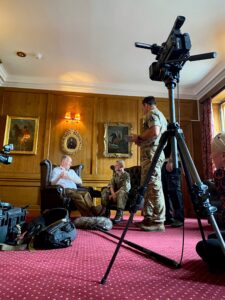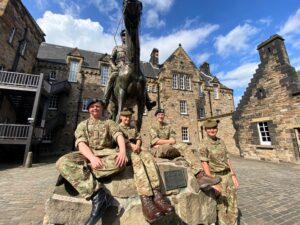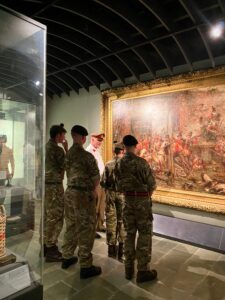
On Thursday 17 August four Cadets from Lothian and Borders Battalion Army Cadet Force (ACF) found themselves in the spotlight at Edinburgh Castle. Cadet Lance Corporal Yeoman, Cadet Stevenson, Cadet Wall and Cadet Glass had been invited by the British Army to take part in a day of filming with the Governor of Edinburgh Castle, Major General Alastair Bruce.
As part of an ongoing Army project to celebrate Scottish martial (military) history, the aim of the day was to capture the Cadets, the Governor, and soldiers from the Royal Regiment of Scotland discussing key historical characters and artefacts. Edinburgh Castle provided an inspiring and iconic backdrop, allowing the stars of the show to explore and examine ancient treasures behind the drawbridge.
After a spot of lunch in the mess and enjoying the One o’clock Gun, the Cadets were guided to the Officers’ Mess where the interviews would take place. Taking it in turns, the Cadets were filmed with the Governor, discussing topics that included Robert the Bruce, the Pals’ Battalions and Robert Gibb’s painting, ‘Closing the Gate at Hougoumont’.
As the day got warmer and the interview room got stuffier, the Governor sprang to his feet and suggested he escort the Cadets around the Castle on a private tour. Quite thrilled, the Cadets, soldiers and media team leapt to attention and followed the Governor as he guided them through the Castle grounds, expertly navigating the hordes of tourists. Stilled mic’d up, the Governor and Cadets could be filmed naturally as they inspected statues, paintings, architectural features and military objects.
The Governor’s capacity to make martial history (both ancient and recent) come to life was exemplified when he took the four Cadets into the National War Memorial. Cameras down, the Governor took the time to remember men he had fought with, recounting his own experience of war and camaraderie. This raw and heartfelt moment, away from the cameras, clearly struck a chord with the Cadets, giving the notion of ‘remembrance’ a greater and more authentic meaning.
Major David Stewart, who managed the project on behalf of the Army, said: ‘The Cadets exuded positivity from the outset. They were confident, incredibly articulate and knowledgeable of their country’s rich history. I was most impressed with their knowledge of significant military events and their interest in seeking the connection that they had with modern day soldiers and their experiences on operations. They were able to speak directly to the camera without direction and made the day run seamlessly.’
When considering the importance of the younger generation engaging in Scotland’s martial history, Major Stewart remarked: ‘Scotland’s military history, from the legendary Picts and the iconic Highland regiments to the Jacobite uprisings and the two World Wars, showcases tales of bravery, innovation, and determination that continue to inspire.
‘By appreciating these traditions, the younger generation can connect with their ancestors, fostering a profound sense of belonging and pride. Furthermore, the stories, tactics, and strategies employed throughout history offer lessons in leadership, teamwork, and problem-solving, invaluable for any generation.
‘Learning about Scotland’s military traditions is not just about warfare but about understanding the sacrifices made, the values upheld, and the transformative impact of these events on shaping the Scotland we know today.’
Undoubtedly impacted by all they had met, seen and learned, it was clear that the Cadets thoroughly enjoyed their day up at the Castle with the Governor. However, the feelings were obviously mutual, with many commenting on how confident and impressive the young Cadets were. Thrown in at the deep end, the Cadets carried themselves with dignity, willingness and enthusiasm throughout the day, whilst often being well out of their comfort zones. Yeoman, Stevenson, Wall and Glass were exemplary ambassadors for the ACF, demonstrating the tremendous value of being involved with the Cadets.












